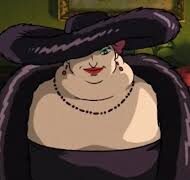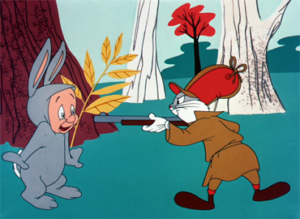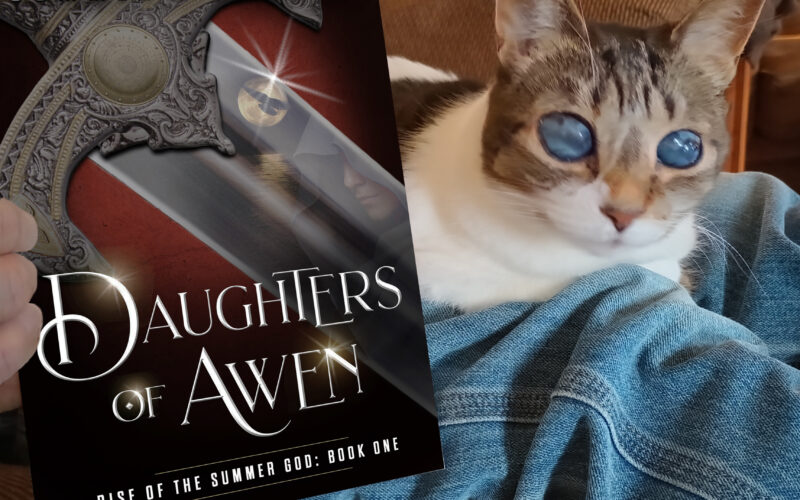Christopher Vogler's The Writer's Journey
The Shadow, Ally, & Trickster
Are we done with archetypes now? Almost!
There are just three more archetype chapters in Christopher Vogler’s book, The Writer’s Journey, and we have issues with two of them.
The Shadow feels more like a force than a character and anyone from a legit supporting actor to unnamed gofer can be labeled an Ally. The one archetype we did like was the Trickster, whose actions and words can bring much needed chaos to your story. They all make for great discussions in this episode.
For literary examples we turned to Howl’s Moving Castle and The Witcher books and video games (NOT the show).
Our Novel Approach to The Writer's Journey
We’ve chosen four novels to analyze while we read Vogler’s book, which will serve as examples to help you on your own journey to writing a novel based on the Hero’s Journey. Here’s what Kim & Renee are reading:
- Next up! Kaiju Preservation Society!
We Survived the Archetypes!
Oh boy oh boy, we finally got through the Archetypes section of The Writer’s Journey! That was no easy feat, given we had to fill in the blanks from Vogler’s outdated examples and (like the Shapeshifter episode) rather sexist explanations. You’re welcome, btw.
Archetypes in Howl's Moving Castle

In this episode, we continue to apply the characters from Diane Wynne Jones’ novel to illustrate Vogler’s Archetypes (again, you’re welcome). Although the plot of Howl’s Moving Castle doesn’t quite fit the Hero’s Journey mold, the archetypes mostly do, especially if you squint a little bit and take a shot of whiskey. Here’s the list of previous archetypes as they pertain to Jones’ characters.
If you enjoy these Snark Notes (mostly written under the influence by Renee), you can always buy her a cup of coffee to sober her up. You can tip us here at Buy Us a Cocktail. . .I mean, Coffee.
The Shadow
There’s a lot to unpack in this chapter and a lot of it is annoyingly sexist. But before we get to the not-so-useful-sexist examples, we’ll start with Vogler’s description of the Dramatic Function:
The function of the Shadow in drama is to challenge the hero and give her a worthy opponent in the struggle. Shadows can create conflict and bring out the best in a hero by putting her in a life-threatening situation.
In other words, the Shadow exists to be in contrast to the Hero, which doesn’t bode well for an interesting character, ngl. This archetype works if the Villain is the source of all obstacles in the way of the Hero’s goal. But unless you’re writing some Batman fanfic, most (non-plot driven) stories aren’t so rigid.
Villain vs Antagonists
Vogler makes the distinction between an antagonist and the Shadow/Villain. Villains are in it for the destruction of the hero, while antagonists simply don’t agree in some way with the hero. In other words:

So how do heroes and protagonists differ? Vogler doesn’t really say, but we do in our What Makes a Hero episode.
Some Useful Stuff
Vogler does give us some helpful advice when it comes to the Shadow. For one, he mentions the Shadow can be worn like a “mask” by other characters; an Ally could turn Villain; and Villains should be humanized and can even represent the internal struggle of a Hero. On the podcast, we discuss how the advice here is neither original nor profound, yet we concede that may not be the point of The Writer’s Journey. This book is not about writing a ‘good’ book. It’s about writing plots and characters universally liked by Western audiences.
The Shadow in Howl's Moving Castle
Renee and Kim had some differing opinions here, so we’ll include a couple to illustrate how the Shadow isn’t always just some easily identifiable big-bad.

The Witch of the Waste. With a name like that, all logic points to this character as the Shadow. Within the second chapter of the novel, the Witch puts a spell on the Hero, Sophie, turning her into an old woman. Sophie spends the rest of the novel trying to undo the curse. Vogler says Shadows “are in opposition to the Hero,” and that’s exactly what the Witch of the Waste is.

Lily Angorian/The Witch of the Waste’s Fire Demon. While not in the movie, this is the true villain of the novel. In the last chapter of Howl’s Moving Castle, we learn the Witch of the Waste wasn’t as bad as all that. She was corrupted by her own fire demon (a fate destined for Howl if he didn’t find a way to get his heart back from Calcifer). The fire demon manifested itself into another character, Lily Angorian, who put a spell on Howl via the poem “Song” by John Donne.
The Bechdel Test
Before we tackle the topic of sexist writing advice yet again, we’d like to preface this with some writing advice you should actually follow. Enter, the Bechdel Test. Coined and illustrated by Allison Bechdel in the comic, Dykes to Watch Out For, she develops three simple rules for how a woman should be depicted in a film. Spoiler: most films, even contemporary ones, fail this test.
How Not to Design a Female Character
Ok, now onto Vogler’s advice (aka, how not to design a female villain because it’s 2024 and we’re sick of this $#!t):
In some stories, the person who starts out as the hero’s love interest shifts shape so far that she becomes the shadow, bent on the hero’s destruction. Femmes fatales are often called “shady ladies.” This might represent a struggle between a person’s male and female sides, or obsession with the opposite sex turned into a psychotic state of mind.
Shady Ladies…um…yeah. Needless to say, we’re not exactly keen on that outdated, sexist term, nor the tired gender tropes it rode in on. Is it too much to ask that women as characters not merely be defined in (sexually deviant) contrast to men? Yes, Vogler sprinkles in female pronouns throughout his book as if that covers all gender equality bases, but that equality stops short when his example of a female villain is The Lady from Shanghai, an outdated film made in the 40’s (not exactly a decade known for its gender equality) that’s not even on anyone’s contemporary radar. Yeah, sure, one could argue Vogler hints a male hero could have a female side, but we aren’t buying it.
Case in point, not a paragraph later he references Hannibal Lector in Silence of the Lambs as a Shadow wearing the mask of a Mentor. Vogler could just have easily discussed Jodie Foster’s character, Clarice, as the Hero up against every man in the film.

Is it too much to ask that a writing advice (and our contemporary literature) not come with a side of sexism? For more about this topic, you can hear Renee go nuclear on the Shapeshifter episode. To conclude, here is a chart, designed by book coach Seth Milawski, from his article in Overthinkingit.com which breaks down the myriad of stereotypical ways women are written in media.
Allies
Girlfriends. Bros. Posse. Gang. Crew. Friends. Besties. Wing-Person. Sidekick. Whatever you call the people or animals who hang out with your Hero, Vogler states they serve very specific functions:
So, Allies are in stories to do. . .tasks? Vogler suggests Allies are less people with feelings and arc and development and more hired help in service to the hero. On the podcast, we mention the dwarves in Tolkien’s The Hobbit. They do seem rather wooden: there to do tasks, give the hero quests, be saved when they get themselves captured. Sometimes an Ally dies and Bilbo grows as a result, such as Thorin Oakenshield after the battle of Five Armies. But what Samwise Gamgee in Lord of the Rings? Frodo wouldn’t have gotten very far without Samwise the Brave.

The Ally in Howl's Moving Castle

Michael Fisher. Just about any side character, according to Vogler, could be an Ally. In Howl’s Moving Castle, Michael fills in the Ally role (a sidekick even) for Howl who keeps an eye on the castle and fulfills side jobs with low level magic. He also becomes Sophie‘s Ally and has an arc of his own: he falls in love with Sophie’s sister, Martha.
The Trickster
We made it to the Trickster! Not only are we finished with the Archetypes section, we actually enjoyed this one. The final Archetype in Vogler’s book is defined as the character who “embodies energies of mischief and desire for change.” Chaos driven and “enemies of the status quo,” Tricksters offer comic relief in otherwise serious plots and scenes.
Vogler explains Tricksters aren’t inextricably linked to the Hero or serve any deep psychological function. They often serve the audience at the expense of the Hero, “cutting big egos down to size” and “can bring about healthy change.

Renee Geeks Out on The Witcher Books and Game (again)

On the podcast, Renee gushes a bit about her long time love of Geralt (and Dandelion) from the Witcher book series, along with the video games (but not the show – like, seriously Vesemir wanted to make more Witchers? Really?! If you’re going to adapt a series of books, at least pretend to read them).
Dandelion is Geralt’s long time best friend, who, like a classic sidekick, often gets himself kidnapped, or cursed and in need of Geralt’s saving. Geralt is a Witcher, a person who went through a biological and magical transformation to become superhuman in order to kill monsters, and as a result, has lost some capacity for human emotion. Dandelion, in contrast, offers both the audience and Geralt necessary comic relief to contrast the seriousness of killing monsters and sometimes dry political drama. In addition to an Ally, Dandelion is also a Trickster, who causes chaos wherever he goes. He drinks, gets laid, and sings his way through the story.
The Trickster in Howl's Moving Castle
Although they don’t really make an appearance in the movie, Sophie’s sisters, who use a spell to switch places, fulfill Vogler’s functions of the Trickster. One sister, Martha, tells Sophie that her step mother is just using her to get rich off of all the hats Sophie makes for her in the hat shop, which changes the status quo.

Howl Jenkins Pendragon. On an obvious level, womanizing, wandering, unpredictably goo dripping Howl is a trickster. He’s a main character, ally, Mentor, Shapeshifter as well, but his unpredictable nature and hilarious obsession with beauty products fits the Trickster bill.















Not Your Usual Words to Write By: The AI Podcasting Challenge
Authors & AI SeriesEpisode 7: Not Your Usual Words to Write By: The AI Podcasting Challenge! Is nothing sacred? After exploring how AI might steal our writing jobs, we’re...